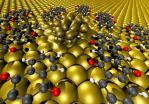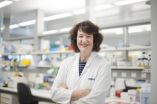(Press-News.org) Until now, however, it was practically impossible to accurately predict which molecules performed well on the job. They basically had to be identified by trial-and-error.
Now, an international team of scientists around Dr. Georg Heimel and Prof. Norbert Koch from the HZB and the Humboldt University Berlin has unraveled the mystery of what these molecules have in common. Their discovery enables more focused improvements to contact layers between metal electrodes and active materials in organic electronic devices.
"We have been working on this question for a number of years now and could at last come up with a conclusive picture using a combination of several experimental methods and theoretical calculations," Georg Heimel explains. The researchers systematically examined different types of molecules whose backbones consist of the same chain of fused aromatic carbon rings. They differed in just one little detail: the number of oxygen atoms projecting from the backbone. These modified molecules were placed on the typical contact metals gold, silver, and copper.
Using photoelectron spectroscopy (UPS and XPS) at HZB's own BESSY II synchrotron radiation source, the researchers were able to identify chemical bonds that formed between the metal surfaces and the molecules as well as to measure the energy levels of the conduction electrons. Colleagues from Germany's Tübingen University determined the exact distance between the molecules and the metal surfaces using x-ray standing wave measurements taken at the ESRF synchrotron radiation source in Grenoble, France.
These experiments showed that, upon contact between the oxygen atoms protruding from the backbone and several of the metals, the molecules' internal structure changed in such a way that they lost their semiconducting properties and instead adopted the metallic properties of the surface. Despite similar prerequisites, this effect was not observed for the "bare"-backbone molecule. From the observation which molecules underwent these kinds of drastic changes on what metal, the researchers could derive general guidelines. "At this point, we have a pretty good sense of how molecules ought to look like and what their properties should be if they are to be good mediators between active organic materials and metal contacts, or, as we like to call it, good at forming soft metallic contacts," says Heimel.
INFORMATION:
Experts from a number of other German universities and from research facilities in Suzhou (China), Iwate and Chiba (Japan), and ESRF (France) have also contributed substantially to this publication.
For additional information please contact Prof. Dr. Norbert Koch
Fon: +49 30-20 93 78 19
E-Mail: norbert.koch@helmholtz-berlin.de
E-Mail: norbert.koch@physik.hu-berlin.de
Organic electronics -- how to make contact between carbon compounds and metal
2013-02-18
ELSE PRESS RELEASES FROM THIS DATE:
'Activating' RNA takes DNA on a loop through time and space
2013-02-18
Long segments of RNA— encoded in our DNA but not translated into protein—are key to physically manipulating DNA in order to activate certain genes, say researchers at The Wistar Institute. These non-coding RNA-activators (ncRNA-a) have a crucial role in turning genes on and off during early embryonic development, researchers say, and have also been connected with diseases, including some cancers, in adults.
In an online article of the journal Nature, a team of scientists led by Wistar's Ramin Shiekhattar, Ph.D., detail the mechanism by which long non-coding RNA-activators ...
Dopants dramatically alter electronic structure of superconductor
2013-02-18
UPTON, NY - Over the last quarter century, scientists have discovered a handful of materials that can be converted from magnetic insulators or metals into "superconductors" able to carry electrical current with no energy loss-an enormously promising idea for new types of zero-resistance electronics and energy-storage and transmission systems. At present, a key step to achieving superconductivity (in addition to keeping the materials very cold) is to substitute a different kind of atom into some positions of the "parent" material's crystal framework. Until now, scientists ...
'Snooze button' on biological clocks improves cell adaptability
2013-02-18
The circadian clocks that control and influence dozens of basic biological processes have an unexpected "snooze button" that helps cells adapt to changes in their environment.
A study by Vanderbilt University researchers published online Feb. 17 by the journal Nature provides compelling new evidence that at least some species can alter the way that their biological clocks function by using different "synonyms" that exist in the genetic code.
"This provides organisms with a novel and previously unappreciated mechanism for responding to changes in their environment," said ...
Microbes team up to boost plants' stress tolerance
2013-02-18
UNIVERSITY PARK, PA. -- While most farmers consider viruses and fungi potential threats to their crops, these microbes can help wild plants adapt to extreme conditions, according to a Penn State virologist.
Discovering how microbes collaborate to improve the hardiness of plants is a key to sustainable agriculture that can help meet increasing food demands, in addition to avoiding possible conflicts over scare resources, said Marilyn Roossinck, professor of plant pathology and environmental microbiology, and biology.
"It's a security issue," Roossinck said. "The amount ...
Ancient teeth bacteria record disease evolution
2013-02-18
DNA preserved in calcified bacteria on the teeth of ancient human skeletons has shed light on the health consequences of the evolving diet and behaviour from the Stone Age to the modern day.
The ancient genetic record reveals the negative changes in oral bacteria brought about by the dietary shifts as humans became farmers, and later with the introduction of food manufacturing in the Industrial Revolution.
An international team, led by the University of Adelaide's Centre for Ancient DNA (ACAD) where the research was performed, has published the results in Nature Genetics ...
Wiring the ocean
2013-02-18
For most people, the sea is a deep, dark mystery. That is changing, though, as scientists find innovative ways to track the movements of ocean-going creatures.
Stanford marine sciences professor and Stanford Woods Institute Senior Fellow Barbara Block is using technology to enable live feeds of animal movements relayed by a series of "ocean WiFi hotspots." This could help protect marine ecosystems by revolutionizing how we understand their function, population structure, fisheries management and species' physiological and evolutionary constraints.
Block will explain ...
Excessive TV in childhood linked to long-term antisocial behaviour
2013-02-18
Children and adolescents who watch a lot of television are more likely to manifest antisocial and criminal behaviour when they become adults, according to a new University of Otago, New Zealand, study published online in the US journal Pediatrics.
The study followed a group of around 1000 children born in the New Zealand city of Dunedin in 1972-73. Every two years between the ages of 5 and 15, they were asked how much television they watched. Those who watched more television were more likely to have a criminal conviction and were also more likely to have antisocial ...
Pathway controlling cell growth revealed
2013-02-18
A Melbourne-based research team has discovered a genetic defect that can halt cell growth and force cells into a death-evading survival state.
The finding has revealed an important mechanism controlling the growth of rapidly-dividing cells that may ultimately lead to the development of new treatments for diseases including cancer.
The discovery was made by Associate Professor Joan Heath, Dr Yeliz Boglev and colleagues at the Melbourne-Parkville Branch of the Ludwig Institute for Cancer Research. Dr Kate Hannan, Associate Professor Rick Pearson and Associate Professor ...
Douglas A. Melton to Keynote present at Stem Cell Summit - Apr 2013 in Boston MA
2013-02-18
Douglas A. Melton will give a keynote presentation on "How To Make Pancreatic Beta Cells" at the Stem Cell Summit 2013 (Apr 29-30, 2013 in Boston MA).
Dr. Melton's presentation will focus on the research of making human pancreatic beta cells to study and treat diabetes. This goal is pursued with two main approaches: directing the differentiation of stem cells into beta cells and studying the signals that replicate pre-existing beta cells. The signals that direct stem and progenitor cells toward a mature beta cell phenotype will be described as well as work ...
Abbey Design Center Wins Talk of the Town Award for Customer Satisfaction
2013-02-18
Achieving the highest customer satisfaction rating of 5 stars, Abbey Design Center has won the prestigious CMUS Talk of the Town Customer Satisfaction Award in the Home Improvement & Remodeling category.
The Talk of the Town Awards, presented by Talk of the Town News, Customer Care News magazine and Celebration Media U.S. (CMUS), honor companies and professionals that provide excellent customer service as reported by their customers through no-cost, user-review websites, blogs, social networks, business rating services, and other honors and accolades. This data ...

